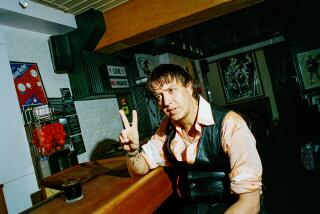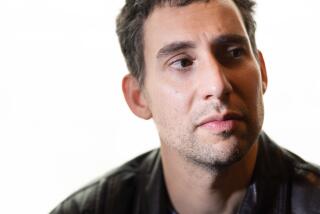The Blare Necessities
- Share via
Thanks to Prodigy and the Chemical Brothers, the machine-driven dance music known as electronica has made enough inroads into the mainstream to create a set of expectations and stereotypes.
In song-oriented rock, there’s a meeting of wills halfway, with the music and a visual performance offered by the performer and embraced by the audience. It’s a form of entertainment in sync with the Latin root-meaning of “entertain,” which is “hold between.”
In electronic dance music, the point isn’t meeting, but absorption. The extreme, jackhammer beats and the loud technological gurgle of synthesizers aims at dazing, hypnotizing and enveloping the beholder, as if he or she had been wired directly into the current producing the sound. It’s not about holding between, but holding within.
Cirrus, an electronic trio from Long Beach, wants to get beyond stereotypes, and maybe give the reluctant and the uninitiated a pathway into rock’s newest wave.
The stereotypes start crumbling the instant you step through the door of Stephen James Barry’s apartment. Instead of acting like severe musical technocrats, the barefoot, ponytailed Barry and Aaron Carter, his closely shorn, goat-bearded founding partner in the band, are smiling as Barry dandles his 9-month-old daughter, who has her dad’s round, apple-cheeks. A little later, Rene Padilla, an adjunct member who completes the trio on vocals and percussion, shows up and begins extolling the virtues of funky, soulful music.
Along the staircase, on the room’s most prominent wall, is a large, signed portrait print of the Beatles. And in a corner, beside a record company promo shot of Cirrus, is a photograph of Elvis Presley.
“I’m a [Beatles] fan,” Barry said. “I like the songwriting and the fact they could all get together and make something nobody had ever heard before. That basically is what we’re doing--making the new kind of music. Maybe we’re not going to make as big strides in advancing music, but I think we’re helping, along with the whole [electronic] scene, in making another avenue for people to explore. Alternative music has been done to death.”
The two Cirrus albums--last year’s “Drop the Break” and the just-released “Back on a Mission”--don’t try to knock a listener insensate with an electronic blast, but instead can be seen as attempts to coax new fans with elements carried over from song-oriented rock.
A Coaxing Approach
There’s a good deal of strong singing. On “Drop the Break,” soul-gospel is the main vocal style, courtesy of Cheryl Carter, Aaron’s mom. She raised him in the Pentecostal Baptist church, where she served as musical director for a congregation in Compton. With “Back on a Mission,” Carter and Barry step forward with rapping that has drawn comparisons to the Beastie Boys; Padilla, who had a cameo on the first album, contributes to most of the new tracks with vocals grounded in the traditions of old line soul and disco.
With Barry on guitar and bass, Carter on bass and turntables and Padilla on percussion, Cirrus’ live approach calls for lots of real-time performance, along with manipulations of recorded elements.
Scattered across the two albums are grooves and textures that can recall Santana and War, Middle Eastern music and Parliament-Funkadelic.
For “Times Running Out,” the climactic production number of “Back on a Mission,” Cirrus sampled an inspirational speech from the Rev. Jesse Jackson, nicked a driving, staccato rock riff from “Jesus Christ Superstar,” and adorned it with symphonic orchestrations in which the sounds were digitally generated and strung together in the band’s studio in the front room of a decrepit house near downtown Long Beach.
For dessert, on a hidden track, they sample the voice of blues patriarch Sonny Boy Williamson and construct their own funky, front-porch technological blues shuffle, with ersatz fiddle and guitar.
The idea, the soft-spoken Cirrus founders say, is to overturn orthodoxies about electronic music.
“It’s just us having fun, doing what we want to do,” Carter said of the blues excursion.
“We’re just trying to expose people” to all sorts of music, added Barry, while making a point about the pointlessness of boundaries. “If you like blues, you can listen to this [electronic dance version]. And if you like [electronic music] you can listen to the blues.”
Hip-Hop Convert
Barry and Carter’s intersection as partners is almost as unlikely as some of the sonic combinations that have arisen from their partnership.
Though he dutifully went to church with his mom each Sunday and witnessed the ecstatic music-making of the deep, black gospel church, Carter, 25, wasn’t interested in emulating her singing and piano playing. Instead, hip-hop captured him. In his midteens, he became obsessed with becoming a deejay and dropped out of high school to spend eight-hour days perfecting his turntable technique.
Carter first encountered electronic music nearly nine years ago when he attended a warehouse rave on New Year’s Eve, 1989.
“I saw all these people bouncing off the walls. I’d never seen people so happy. It was two years before I realized it was because they were all on drugs. But they do have a passion for [the music].”
Barry dismisses the notion that people need to alter their consciousness to get the point of electronica.
“Drugs are not going to make somebody like something they don’t like already.”
Like Carter, a white kid who grew up mainly among blacks, Barry had a youthful immersion in different cultures, splitting time between Southern California, where he was born to Irish and Scottish parents, and the British Isles, where his homesick mother took him for regular extended visits that could last three months to a year.
He began playing guitar in garage bands while attending Cypress College; then he transferred to Golden West College for the record engineering program there. Carter, who had begun to promote his own raves to showcase his deejaying skills, was in the same class. For nearly a year, Carter said, “We didn’t know each other existed.”
But one day in 1994, Carter overheard Barry telling the instructor he needed a sampling machine to record a rap artist he was working with; Carter volunteered a unit he’d just purchased, for a half share of the $40 session fee.
Soon, Carter was indoctrinating Barry into electronic music, and the two set up a studio at Barry’s house in Downey.
“It was intriguing,” said Barry, 25. “I’d just barely learned at school how to work all of that [gear], and it sounded like something you would hear on the radio or on a CD. We impressed ourselves a little bit.”
They also impressed executives at Moonshine Records, a Los Angeles-based electronic music label, who heard a tape sent by Carter’s then-girlfriend. “Future,” one of the first tracks the duo had made, came out as a single. The track also marked the record debut of Padilla, a friend of Barry’s who had sung in one of his garage-rock bands. Padilla was hanging out at Cirrus’ home studio when the duo asked him to go in the bathroom and think up something to add vocally to “Future.”
Padilla had just been listening to Marvin Gaye on his car stereo, so he intoned some lyrics from “What’s Goin’ On.”
Padilla, 26, remained unimpressed with Cirrus until late in 1995.
“I didn’t want to try out with these guys. Electronica? Where’s the funk at? Where’s the soul? To me, it was just a bunch of noise.”
‘The Vibe, the Feeling’
He changed his mind during a road trip to Texas, where he had agreed to help Cirrus as a crew member and guest singer.
“I just went and acted like a fool for a few songs, but then I saw the crowd reacting and dancing to what we were doing.”
Now Cirrus is trying to stay true to electronic music’s hypnotic impact while answering the sorts of doubts that Padilla initially had.
At its core, Carter said, electronica “is an attack on the senses.”
Cirrus gives it a less forbidding spin. The new album, Barry said, “is a lot less electronic than a lot of the music. [Most electronic music] is not something you’re going to want to listen to driving in your car and chilling at home. It’s only something you want to party to. I think this record is something you can listen to.” If the music is to be labeled, he said, “funky techno” is a more descriptive tag than the nebulous “electronica.”
*
For the past 1 1/2 years, Cirrus members have been full-time musicians, living close to the margin, but able to leave behind their day jobs. After a summer tour opening for the gothic-industrial band My Life With the Thrill Kill Kult, Cirrus will headline Moonshine Overamerica, a 26-date national tour that begins tonight at the Galaxy; the trio’s first European dates will follow later this fall as Cirrus tries to ride electronica out of the underground.
“We make it to share with people,” Carter said. “I guess we’d just like people to be more open-minded and listen to the music before they judge it.”
* Moonshine Overamerica, with Cirrus, Keoki, John Kelley and Tall Paul, tonight at the Galaxy Concert Theatre, 3503 S. Harbor Blvd., Santa Ana. 8 p.m. $10-$12. 18 and over only. (714) 957-0600.
More to Read
The biggest entertainment stories
Get our big stories about Hollywood, film, television, music, arts, culture and more right in your inbox as soon as they publish.
You may occasionally receive promotional content from the Los Angeles Times.











